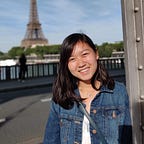How Has Design Evolved in Blueprint Since our Rebrand?
A brief history of design within Blueprint and anticipating what is to come.
About a year and a half ago, we redesigned our logo. We got rid of the much loved gear and paw-print we had since 2012 for something more clean and modern. Though the main reason for our rebranding was to better appeal to our wide audience of students, nonprofits and sponsors, it also signalled that we were ready for a greater focus towards design at Blueprint.
Since then, our brand has evolved through multiple rounds of tinkering and trial and error. We are constantly brainstorming ways to deliver delight, warmth, excitement and innovation through our visual identity. These ideas have greatly influenced our flyers, graphics, and social media posts in recent semesters.
Design Education & UIUX Support
Blueprint has taken this same thoughtfulness for design and applied it to the applications we build through a greater focus in UIUX design education. Pamela Hu (Design Director Fall 2017) was the first to go beyond her marketing role and introduce design to the club as a whole. She did this through engaging bi-weekly design presentations that were palatable for anyone, even the headstrong developer, to get them interested in design.
Grant Kalasky (Design Director Spring & Fall 2018) took this vision even further by getting more involved in the UIUX of our Spring 2018 projects with design critiques and UX support. This sparked constant conversation on best UX practices and thinking from a user’s perspective.
Design Vision
By Fall 2018, it became clear that we had a blossoming interest in design within our club, and the resources to back it up. Given this platform to exercise our creativity and thoughtfulness, we wanted to take Blueprint design even further. We decided to set these goals for ourselves:
1) To produce beautiful, usable, accessible applications that truly meet the needs of the communities we serve.
This goal ties together with the mission statement of Blueprint: “To make beautiful engineering accessible and useful for those who create communities and promote public welfare.” We strive towards this by giving thorough attention to the UIUX design of our applications. Each of our project teams has at least one designer who is responsible for creating wireframes and, eventually, high-fidelity mock-ups. In addition, we engage in bi-weekly design critiques to exchange feedback.
2) To uphold a consistent, beautiful, and thoughtful brand identity.
When we first rebranded, we were pretty loyal to, and probably overused our signature blue. Gradually, with each graphic we create, we have constantly strived for bolder and fresher visuals.
We wanted to keep our designs exciting and have fun while at it. This has resulted in us trying new things: from the first recruitment concept that strayed away from our signature blue, to duo-tones & pop colours as profile pictures. Although we have embraced our move away from strict design guidelines, we have always taken the effort to ensure that our brand is friendly and approchable.
3) To share knowledge within and beyond.
To cater to the growing interest and conscientiousness towards design within our club, we created a design committee. This committee consists of designers from each project and any other members who wanted to learn more about design. Aside from UIUX critiques, the committee also brainstorms new marketing concepts and designs club merchandise.
We continued with internal design presentations on topics such as design thinking and best wire-framing practices to give developers the option of integrating design with their projects. Grant conducted a Figma tutorial workshop which was very well received — by teaching the tools required, it made designing seem more accessible.
4) To find and document design processes that work well for us.
It is increasingly common for teams to seek to use design processes to kickstart their projects. For example, journey mapping user flows or sketching the interface as a visual way to architect the application. Hence we have begun compiling and documenting design exercises and best practices in Notion for anyone to consult. These resources are not meant to be a strict guideline for teams to adhere to, but rather a means to aid projects in creating solutions that truly meet the needs of users.
What is to come?
The past Fall semester has been rather experimental for design in Blueprint. We are grateful for the open-mindedness of the club to participate in the many ways we have tried to incorporate design in our development processes.
One of our biggest challenges has to do with our fundamental nature as a software engineering club first. Design is still a second class citizen in Blueprint. How do we make design a priority without compromising the quality of our engineering? Going forward, we want to continue to grow and explore how design can enhance our workflow.
Join us!
We are currently looking for a new Design Director for Spring 2019 and beyond. Blueprint provides an amazing space to hone, explore and showcase your design skills — Be it graphic design or UIUX. Apply here by February 1st. Know someone perfect for this role? Tell them to apply!
